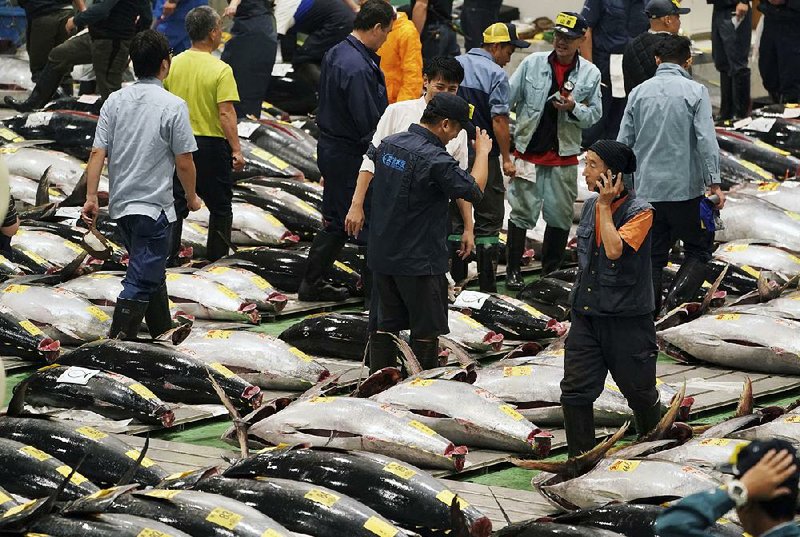TOKYO -- Tokyo's famous fish market reopened Thursday at a new location but retained its most famous tradition: the tuna auction.
The customary clanging of bells opened the auction for raw and frozen tuna, which crammed the huge warehouse wall to wall, at the waterfront Toyosu facility. The rhythmical shouts of the auctioneers and the special hand signals by the bidders that followed were unchanged from Tsukiji, the smaller, more accessible home the market recently left after more than eight decades.
The top bid for a tuna, a delicacy much like premium-grade beef in Japan, was $38,000, not an unusually high price for quality tuna.
The more than 400 kinds of seafood at the market are netted from all over Japan, as well as from abroad, including octopus, eel, sea urchin and other items special to Japanese cuisine.
The market serves top restaurants and everyday supermarkets alike. The move was delayed for two years because of worries about contamination, including arsenic, at the Toyosu site. Measures were taken to ensure safety, such as better water pumps and extra concrete sealing.
Tokyo Gov. Yuriko Koike attended the opening and expressed hopes for the market's success.
"Of course, things are different here," she said of how the new place may take getting used to.
"We must build the Toyosu brand, day by day, to make it a symbol of Tokyo, and of Japan. I hope to move forward with all of you."
Officials and workers then clapped rhythmically in celebration of Toyosu's opening, the same customary gesture for good luck that had closed Tsukiji on Oct. 6.
Yasuhiro Yamazaki, the president of Yamaharu Co., one of about 500 intermediate fishery wholesalers at the building, was busy checking the quality of purchased fish and giving shipping instructions to his employees.
"Now that Toyosu market has opened, it's no use talking about our worries. We have no choice but to make Toyosu a globally known market."
A total of 1,733 tuna were traded at Thursday's tuna auctions, about twice as much as on the final business day of Tsukiji market.
Free tours for the public start Saturday, including seeing the auction through a huge glass window. Visitors will not be able to go on the auction floor as they could at Tsukiji. Reporters got a tour of the grounds Thursday.
Like Tsukiji, Toyosu also has a vegetable wholesale area, where auctions also take place. In several spots in the same market complex are tiny restaurants, including the ones that used to be at Tsukiji but also new ones.
Still, much of the quaint atmosphere of Tsukiji was gone in the sterile factorylike environment of Toyosu. Whether Toyosu can attract tourist traffic remains to be seen.
Serving as reminders were the people zipping around in their scooting carts, as busy as ever.
Toyosu is a bit farther to get to than Tsukiji, which is within walking distance of downtown Ginza. Toyosu is reachable by a driverless monorail called Yurikamome. A walkway from Shijo-mae station, which means "in front of the market," leads right to the Toyosu market.
About 40,000 people used to visit Tsukiji each day, not just retailers and restaurant operators but also "salarymen" on lunch breaks and tourists from all over the world.
It's unclear whether the stalls serving noodles and raw-tuna bowls that remain in the area surrounding Tsukiji will continue to be a draw without the backdrop of a real market.
Many fish wholesalers, workers and supporters had opposed the move out of Tsukiji, alleging that Toyosu was inefficient and unsafe. A few businesses were continuing to sell inside Tsukiji, saying they hoped to fight the planned tearing down of the old construction.
Tsukiji is being turned into a parking lot for the 2020 Tokyo Olympics. What gets built afterward is undecided, according to the Tokyo city government. But it's clearly prime real estate, and plans under consideration include a casino.
"Today marked the start of hope at Toyosu," Yasutoshi Maki, the president of fruit and vegetable intermediate wholesaler Sadamatsu.
Sadamatsu has operated since the opening of Tsukiji market in 1935, and Maki frequented the market from the time he was about 3 years old. "Tsukiji's attraction was that it was not organized, but at Toyosu, it's easy to move around, as there's a good traffic flow from the wholesalers to intermediate wholesalers."
At Toyosu market, some restaurant and retail store employees got lost as they ran errands. Iori Muroi, an operator of a Japanese restaurant in Tokyo's Iidabashi district, rushed to return to the restaurant.
"I wasted more than an hour going back and forth while looking at a map. I have to get ready for our lunchtime operations."
Former Tokyo Gov. Shintaro Ishihara decided in 2001 to move Tsukiji market to the Toyosu site, where a Tokyo Gas Co. factory once stood. However, a large amount of toxic substances, far in excess of environmental standards, were found in the soil, and this and other problems threw the relocation plan into disarray. Major work to deal with the contaminated soil was carried out.
Information for this article was contributed by Yuri Kageyama of The Associated Press and by The Japan News.
Business on 10/12/2018
